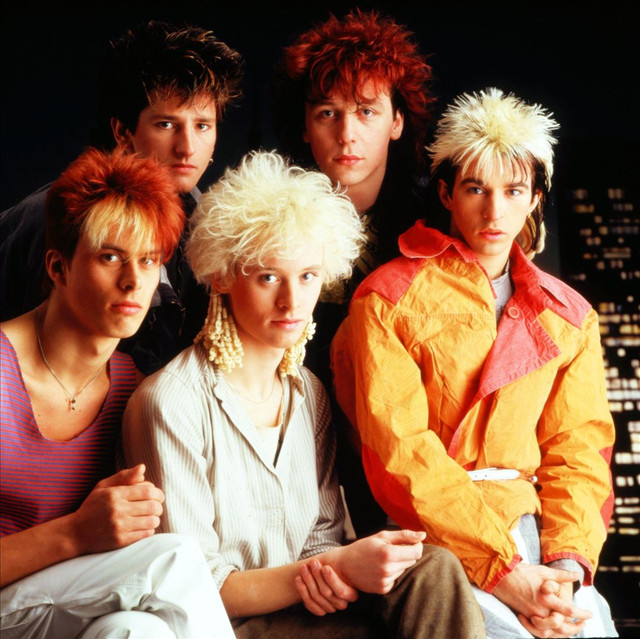Kajagoogoo, a British new wave band that emerged in the early 1980s, carved out a unique niche in the music industry with their catchy melodies, innovative sound, and distinctive fashion sense. From their chart-topping debut single “Too Shy” to their evolution as a band and subsequent solo ventures, Kajagoogoo’s story is one of creativity, collaboration, and resilience.
The roots of Kajagoogoo can be traced back to Leighton Buzzard, a town in Bedfordshire, England, where founding members Nick Beggs (bass guitar, vocals), Steve Askew (guitar), and Stuart Neale (keyboards) first crossed paths. Bonding over their shared love for music and a desire to create something new and innovative, they began writing songs and honing their musical skills together.
In 1981, the trio joined forces with drummer Jez Strode and vocalist Christopher Hamill, who would later adopt the stage name Limahl, to form the band Art Nouveau. Drawing inspiration from the burgeoning new wave and synth-pop movements of the early 1980s, they set out to craft a sound that was both modern and accessible, blending infectious pop hooks with electronic textures and pulsating rhythms.
In 1982, Art Nouveau caught the attention of record label executive Chris Hamill (no relation to Limahl), who was impressed by their demo recordings and saw potential in the band. Under his guidance, they signed a record deal with EMI Records and rebranded themselves as Kajagoogoo, a name inspired by a character from the children’s book “Kerplunk!” by John Burningham.With their new name and a fresh sound, Kajagoogoo burst onto the music scene in 1983 with their debut single “Too Shy.” The song, characterized by its infectious synth riff and Limahl’s distinctive falsetto vocals, became an instant hit, topping the charts in several countries and catapulting the band to international fame virtually overnight.
Following the success of “Too Shy,” Kajagoogoo released their debut album, “White Feathers,” later that year. The album, featuring a mix of upbeat pop tunes and moody ballads, received favorable reviews from critics and further solidified the band’s status as rising stars in the music industry. However, behind the scenes, tensions were simmering within the band. Creative differences and personality clashes began to take their toll, leading to friction between the members. In 1983, just as Kajagoogoo was enjoying the peak of their success, Limahl was dismissed from the band amidst growing tensions and disagreements over the direction of their music. Limahl’s departure from Kajagoogoo marked a turning point in the band’s career. While some feared that his absence would spell the end for Kajagoogoo, the remaining members were determined to soldier on and prove that they were more than just a one-hit wonder. In the wake of Limahl’s departure, Kajagoogoo underwent a period of reinvention and experimentation. With Nick Beggs assuming lead vocal duties, the band released their sophomore album, “Islands,” in 1984. Departing from the glossy pop sound of their debut, “Islands” showcased a more mature and eclectic sound, drawing influences from funk, rock, and world music. Despite receiving positive reviews from critics, “Islands” failed to replicate the commercial success of “White Feathers.” The album’s lead single, “The Lion’s Mouth,” failed to chart significantly, and Kajagoogoo struggled to regain their footing in an increasingly competitive music landscape. In the years that followed, Kajagoogoo continued to release music and tour sporadically, but their relevance in the mainstream music scene waned. In 1985, the band parted ways with their record label, EMI Records, and embarked on a hiatus as members pursued solo ventures and other projects.While Kajagoogoo’s time in the spotlight may have been relatively brief, their impact on the music industry is undeniable. With their catchy melodies, innovative sound, and flamboyant style, they helped define the sound of the early 1980s and left an indelible mark on the world of pop music.
Moreover, Kajagoogoo’s story serves as a testament to the power of resilience and reinvention in the face of adversity. Despite facing internal strife and external pressures, the band persevered, continuing to create music and pursue their passion for artistic expression. Today, Kajagoogoo’s music continues to resonate with fans old and new, serving as a nostalgic reminder of a bygone era in pop music. Songs like “Too Shy” and “Ooh to Be Ah” remain timeless classics, beloved by audiences around the world.Kajagoogoo’s journey from humble beginnings to international fame is a testament to the enduring power of creativity, collaboration, and perseverance. Though their time in the spotlight may have been fleeting, their music lives on, inspiring generations of artists and music lovers alike. As they continue to captivate audiences with their infectious melodies and innovative sound, Kajagoogoo remains an iconic and influential force in the world of pop music.
This post has already been read 148 times!











